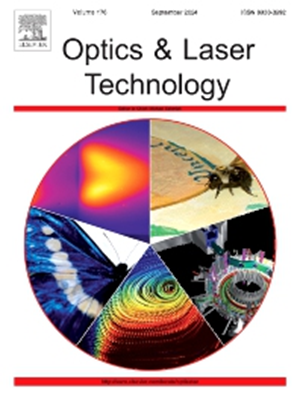Optical-computing-based fiber nonlinearity compensation using a 2×4 micro-ring array
IF 4.6
2区 物理与天体物理
Q1 OPTICS
引用次数: 0
Abstract
This paper presents an optical-computing-based approach for compensating nonlinear impairments in optical fiber communication systems. By leveraging a electro-optically modulated micro-ring array, the proposed method computes the product of three real numbers in a single operation, thereby enabling efficient triplet generation for perturbation-based nonlinear compensation. This approach can significantly boost computational efficiency and lower energy consumption. Our results show that optical-computing triplets provide Q-factor improvements on par with those achieved by electrical-computing triplets, with errors following a normal pattern. The scalability of the architecture is examined for higher-dimensional operations. Despite inherent errors, the artificial neural network can effectively compensate for these discrepancies, demonstrating the excellent robustness and practical value in high-capacity optical networks.
基于光计算的2×4微环阵列光纤非线性补偿
提出了一种基于光计算的光纤通信系统非线性损伤补偿方法。通过利用2×4电光调制微环阵列,提出的方法在一次操作中计算三个实数的乘积,从而实现基于微扰的非线性补偿的有效三重态生成。这种方法可以显著提高计算效率,降低能耗。我们的研究结果表明,光学计算三元组提供的q因子改进与电计算三元组所实现的相同,误差遵循正常模式。对高维操作检查体系结构的可伸缩性。尽管存在固有误差,但人工神经网络可以有效地补偿这些误差,在大容量光网络中显示出良好的鲁棒性和实用价值。
本文章由计算机程序翻译,如有差异,请以英文原文为准。
求助全文
约1分钟内获得全文
求助全文
来源期刊
CiteScore
8.50
自引率
10.00%
发文量
1060
审稿时长
3.4 months
期刊介绍:
Optics & Laser Technology aims to provide a vehicle for the publication of a broad range of high quality research and review papers in those fields of scientific and engineering research appertaining to the development and application of the technology of optics and lasers. Papers describing original work in these areas are submitted to rigorous refereeing prior to acceptance for publication.
The scope of Optics & Laser Technology encompasses, but is not restricted to, the following areas:
•development in all types of lasers
•developments in optoelectronic devices and photonics
•developments in new photonics and optical concepts
•developments in conventional optics, optical instruments and components
•techniques of optical metrology, including interferometry and optical fibre sensors
•LIDAR and other non-contact optical measurement techniques, including optical methods in heat and fluid flow
•applications of lasers to materials processing, optical NDT display (including holography) and optical communication
•research and development in the field of laser safety including studies of hazards resulting from the applications of lasers (laser safety, hazards of laser fume)
•developments in optical computing and optical information processing
•developments in new optical materials
•developments in new optical characterization methods and techniques
•developments in quantum optics
•developments in light assisted micro and nanofabrication methods and techniques
•developments in nanophotonics and biophotonics
•developments in imaging processing and systems

 求助内容:
求助内容: 应助结果提醒方式:
应助结果提醒方式:


